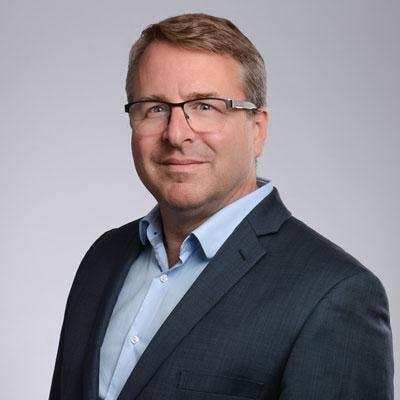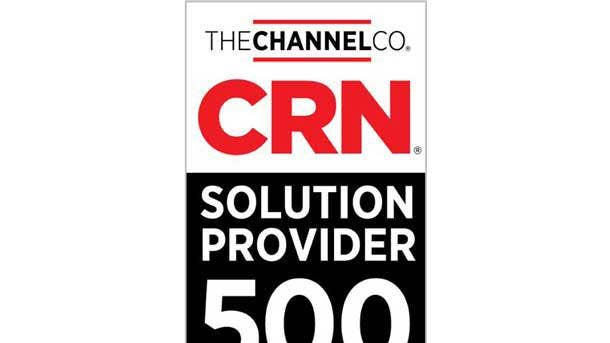Converge CEO On Acquisition Strategy: ‘The Team Will Always Beat An Individual’
‘When you hire by ones and twos, they‘re not a team. And it takes a while for them to embed in a team. When you buy a company, they’re already a team,’ Converge CEO Shaun Maine tells CRN.

Building A Billion-Dollar Solution Provider One Acquisition At A Time
Finding good sales staff, engineers and support personnel is already difficult enough for most solution providers. Trying to find even one or two data scientists, cybersecurity experts and cloud services gurus can be nearly impossible for all but the largest of channel partners. So what is a solution provider to do?
Shaun Maine, CEO of Converge Technology Solutions, said he has found the answer. His company was founded five years ago with the express purpose of building an IT solution provider powerhouse capable of tackling the most demanding customer challenges, including digital transformation and cloud migration, by acquiring other solution providers. The Toronto-based company has in five years acquired 31 companies, the latest being San Diego-based TIG, with the goal of developing enterprise-grade skills and making them available to the midsize customers those 31 solution providers could never provide on their own.
Maine told CRN in an exclusive interview that few solution providers can afford the investment needed to bring much-needed skills to customers, but as a group Converge can.
“[Most solution providers] might have a Microsoft practice,” he said. “But do they have an AWS practice or GCP [Google Cloud Platform] practice? We‘ve got 103 security architects averaging 15 years of experience in our security group. We’ve got 85 data scientists in our analytics group. Those kinds of skill sets, you don‘t see at VARs. And then our cloud practice has all these app modernization people that are helping people put their applications inside Kubernetes containers from Red Hat and VMware and add managed services.”
For Converge, acquisitions are essential to building the kind of talent that will make it a billion-dollar provider of IT services in the next couple of years, Maine said.
“We believe that the team will always beat an individual, no matter how bright they are,” he said. “So we‘re really emphasized that team mentality, and the way that we’ve been bringing on talent is by buying companies rather than hiring individuals. ... When you hire by ones and twos, they‘re not a team. And it takes a while for them to embed in a team. When you buy a company, they’re already a team.”
Here is more on how Maine is building Converge through acquisitions.

Converge has just made its 31st acquisition with TGI. How do you find acquisition targets?
I use your CRN Solution Provider 500 list as target practice. That‘s how I find my acquisitions. And I also love when we’re referring to which number I got on your list. ... I tell everyone that the way that I started the company off was, back in 2017, I went to the CRN website, looked at the big Solution Provider 500 list, and looked at all the companies between $75 [million] and $200 million in sales. At the time there were 175 of them. I picked 82 of those by culture, by customer, by geography and capabilities. And I met with all of them. And I‘ve been working through the list.
You met with all 82 that you chose?
I used to run ProSys Information Systems. We used to hang out with all of these guys at the vendor conferences. So you could go in and meet them at, whether it be Cisco World or some AWS conference, or you‘d be in Vegas for everything. And so you knew these people. And your distributors knew them very well as well because they’re providing credit to them. So Ingram Micro has been very helpful in that. And way back when I was running Pivot [Technology Solutions], Tech Data was my big one there. The distributors have been very helpful in making sure that they‘re the right fit culturally for us as well.

Was Converge formed specifically as a platform for rolling up solution providers into a larger organization?
One hundred percent yes. I was the chief operating officer of Pivot Technology Solutions, which bought five companies: ACS [Applied Computer Solutions] on the West Coast, ProSys, Sigma Technology Solutions in Texas, ARC [Applied Ribbon Company], and the last acquisition, TeraMach, a $100 million reseller in Canada. I realized that smaller resellers don‘t get the benefits in terms of rebates. The larger ones do. And smaller resellers also have midmarket customers, not because they don’t want large enterprise customers, they just haven‘t got there yet. But a better strategy would be to buy these smaller resellers with local services and turn those into cloud and managed service providers because midmarket companies need help getting to the cloud. When I was at Pivot, my largest two customers were AT&T and Apple. They certainly didn’t need any help getting to the cloud. But midmarket companies with education and health-care and finance technology certainly did. And the sales force targeting midmarket companies are 10 years younger [than those targeting enterprises.] They‘re hunting many accounts as opposed to in large enterprises where you’re farming one large enterprise account. And also because they‘re smaller, they have to compete on service levels and technology, because they were swimming against the current. ...
They still compete like that, but they have the backing of Converge and all our capabilities. And therefore you‘re swimming with the current, as we like to say. Plus small companies can’t afford the investment they need. They might have a Microsoft practice. But do they have an AWS practice or GCP practice? We‘ve got 103 security architects averaging 15 years of experience in our security group. We’ve got 85 data scientists in our analytics group. Those kinds of skill sets, you don‘t see at VARs. And then our cloud practice has all these app modernization people that are helping people put their applications inside Kubernetes containers from Red Hat and VMware and add managed services.
And so when we buy a company, the salespeople end up making more money because they‘re able to sell more to their customers. And we actually don’t expect the salespeople to do the selling. We expect them to be relationship managers. And we‘ve got embedded in the practice areas presales architects that will come in and work with them. So the model has worked really well. We’re at 31 acquisitions in less than five years. And it‘s a great team. Some of them have been with us for a very long time.

So 31 acquisitions so far, including TIG. Do you plan to do more?
I originally had a three-phase plan when I started the company. Phase one was a broad-brush geographical coverage in Canada and the U.S., and get close here with the vendors. Phase two was to build out capabilities around hybrid IT, analytics, cybersecurity, cloud and managed services. And phase three, integrate at scale and then get to $2 billion run-rate revenue and $100 million of adjusted EBITDA. We hit that last year. Then we came up with a plan to get to over $5 billion in revenue by the end of 2025 with $500 million of adjusted EBITDA by buying a billion of acquisition revenue per year for the next three years: $400 million in North America and 400 million euros in Europe. We‘ve exceeded the target so far in North America.
So last year, we went to Europe with Rednet in Germany. We bought a smaller solution provider (Visucom) earlier this year in Germany as well. There‘ll be more in Germany. There’ll be a platform in the U.K., and more in Northern Europe. We‘re going after … countries like Germany, the U.K., Benelux, Nordics and Ireland because those are the ones that you can integrate as well. So that’s our focus. And now that we’re pretty well done in North America, except that there might be some smaller ones later this year, the next bigger ones will be in Europe.
Is Converge looking to compete against global systems integrators such as Tata and Accenture?
No. We provide similar functions, though, into the midmarket. They target large enterprises. In the U.S., the midmarket is 500 to 10,000 seats. Those integrators tend to focus on the Fortune 500. So we‘re south of the Fortune 500. And in the midmarket, there’s a different sales force, there‘s a different way of selling into the midmarket. But I don’t know of any IT service provider that has data scientists going into the midmarket. So you might have some security guys, you might even have all the cloud things, but the analytics side is really poorly represented. So when we go into companies struggling with moving unstructured data to the cloud, looking at how to use [IBM] Watson and Snowflake to derive business value, they‘re trying to do it with their own internal IT growth groups and struggling with that. So we have some really great skills that we’re offering to our midmarket customers.

With advanced capabilities like analytics and with the current talent shortage, are you finding the people that you need?
We are, but we have a very different model. So No. 1, the way you keep people is culture. People love to work with other smart people. But we don‘t hire organically as much as we buy companies. When we bought CBI [Creative Breakthroughs] in April, we got 65 security architects. That’s a much better way, with prebuilt teams. Last year, we bought CarpeDatum and LPA [Software Solutions]. That‘s where we got a lot of our data scientists. So we’ll often partner with a services company and then acquire the company. But when you hire by ones and twos, they‘re not a team. And it takes a while for them to embed in a team. When you buy a company, they’re already a team.
When you talk to Converge executives, you won‘t hear a lot of people say ‘I.’ You’ll hear a lot about ‘we,’ ‘us,’ ‘the team.’ … We believe that the team will always beat an individual, no matter how bright they are. So we‘re really emphasized that team mentality, and the way that we’ve been bringing on talent is by buying companies rather than hiring individuals.
When Converge goes to market, does it act as a single company or 31 individual companies? Do they keep their original identity?
So TIG, which we just bought, will be known as ‘TIG, a Converge Company.’ Never change the brand or sales comp in the first year. TIG’s customers know them as TIG. They don‘t really know Converge. Converge, though, is new capabilities and size and scale. And so they still work with the same people who bring in more things that Converge brings to the table. Lighthouse, where Converge President Greg Berard came from, has now done away with the ‘Lighthouse’ brand and operates as Converge. But we don’t rush that process. That has to be a natural process, while the local brand has value. Customers want to know they‘ll have the same great service.
The reason we bought these companies is because this is a people business. And this is all about customers, listening to your customers, understanding their needs, and delivering on that. That‘s the value that we’re buying in these companies. So we want to add to that Converge’s capabilities. And when the customers see that value from Converge, sure, we can migrate it potentially to just a Converge brand. But that‘s only something that the companies themselves decide.

As the acquired companies merge into Converge and become identified as Converge, what benefits do their people get?
No. 1, the salespeople make more money because they‘re selling things that they never could before. Smaller companies do not have the investment dollars to hire world-class cybersecurity and analytics people. And while they might have one cloud, we’ve got an AWS practice, a GCP practice and a Microsoft practice. We‘ve got our own managed services. For these capabilities, smaller resellers just don’t have the investment dollars. And so unfortunately, as resellers, they‘re having to introduce other people into their account to provide those services. And that’s why a lot of resellers want to sell. They‘ve had great customer relationships for 25, 30, 40 years in the case of TIG, and yet they don’t have the some of these capabilities.
If you look at TIG‘s business, 52 percent of it is SLED. We bought [Germany-based] Rednet last year. Rednet has the most beautiful model around a teacher help desk, helping teachers deliver online content within an Azure-based platform for curriculum as well as managed end users. Well, to get that, TIG on its own would have had to invest a lot. Instead, we’re bringing Georgia [Vasilion, TIG’s public sector vice president] over to the Learntec conference in Germany to bring those capabilities back to implement at TIG. So we take best practices across our group. And this is where they‘re benefiting from more services. We bought ExactlyIT for the managed end user aspect. So now TIG can bring to market things in the education sector—the teacher help desk, the managed end-user, the Microsoft Azure platform for curriculum—that they didn’t have in the past.